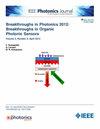Multi-Step Span Loss Prediction in Optical Networks Using Multi-Head Attention Transformers
IF 2.1
4区 工程技术
Q3 ENGINEERING, ELECTRICAL & ELECTRONIC
引用次数: 0
Abstract
Span Loss is a pivotal characteristic of optical networks, and its accurate prediction enables adjustment for optimal performance and proactive monitoring. Deep learning models such as transformers, with their self-attention mechanism, have shown potential for various prediction tasks. In this study, we propose the Transformer-XL (Extra Long) model for single-step and multi-step forecasting, trained with field data. We report on models predicting span loss from 15 minutes to 5 days, using window sizes of 15 minutes to 10 days. The single-step model's average Absolute Maximum Error (AME) is better than the naive model by 2.13 dB and outperforms linear regression by 0.05–0.32 dB across different window sizes. Our single-step model also achieves better performance than the Recurrent Neural Network (RNN) with an AME improvement of 0.02 dB. The average AME of our multi-step model exceeds the naive model's performance by a range of 2.95-3.05 dB, linear regression by a substantial 0.02-0.15 dB and RNN by a range of 0.04-0.54 dB across different window sizes and forecast horizons. Based on Root Mean Square Error (RMSE), the single-step model performs better than the naive approach across various window sizes by 0.07 dB, achieves up to 0.07 dB improvement over linear regression, and delivers comparable results to RNN. Moreover, our multi-step model improves upon the naive approach with RMSE by 0.04 dB and RNN by 0.02 across various window sizes and forecast horizons. It also demonstrates a slight improvement over linear regression.基于多头注意变压器的光网络多步跨度损耗预测
跨度损失是光网络的一个关键特性,它的准确预测可以使调整达到最佳性能和主动监控。深度学习模型,如变压器,具有自我注意机制,已经显示出各种预测任务的潜力。在这项研究中,我们提出了Transformer-XL (Extra Long)模型,用于单步和多步预测,并使用现场数据进行训练。我们报告的模型预测跨度损失从15分钟到5天,使用15分钟到10天的窗口大小。在不同的窗口大小下,单步模型的平均绝对最大误差(AME)比朴素模型好2.13 dB,比线性回归模型好0.05 ~ 0.32 dB。我们的单步模型也取得了比递归神经网络(RNN)更好的性能,AME提高了0.02 dB。在不同的窗口大小和预测范围内,我们的多步模型的平均AME比朴素模型的性能高出2.95-3.05 dB,线性回归的平均AME高出0.02-0.15 dB, RNN的平均AME高出0.04-0.54 dB。基于均方根误差(RMSE),单步模型在不同窗口大小上的表现比朴素方法好0.07 dB,比线性回归提高了0.07 dB,并提供了与RNN相当的结果。此外,我们的多步模型在不同窗口大小和预测范围内的RMSE和RNN分别提高了0.04 dB和0.02 dB。它还显示了相对于线性回归的略微改进。
本文章由计算机程序翻译,如有差异,请以英文原文为准。
求助全文
约1分钟内获得全文
求助全文
来源期刊

IEEE Photonics Journal
ENGINEERING, ELECTRICAL & ELECTRONIC-OPTICS
CiteScore
4.50
自引率
8.30%
发文量
489
审稿时长
1.4 months
期刊介绍:
Breakthroughs in the generation of light and in its control and utilization have given rise to the field of Photonics, a rapidly expanding area of science and technology with major technological and economic impact. Photonics integrates quantum electronics and optics to accelerate progress in the generation of novel photon sources and in their utilization in emerging applications at the micro and nano scales spanning from the far-infrared/THz to the x-ray region of the electromagnetic spectrum. IEEE Photonics Journal is an online-only journal dedicated to the rapid disclosure of top-quality peer-reviewed research at the forefront of all areas of photonics. Contributions addressing issues ranging from fundamental understanding to emerging technologies and applications are within the scope of the Journal. The Journal includes topics in: Photon sources from far infrared to X-rays, Photonics materials and engineered photonic structures, Integrated optics and optoelectronic, Ultrafast, attosecond, high field and short wavelength photonics, Biophotonics, including DNA photonics, Nanophotonics, Magnetophotonics, Fundamentals of light propagation and interaction; nonlinear effects, Optical data storage, Fiber optics and optical communications devices, systems, and technologies, Micro Opto Electro Mechanical Systems (MOEMS), Microwave photonics, Optical Sensors.
 求助内容:
求助内容: 应助结果提醒方式:
应助结果提醒方式:


